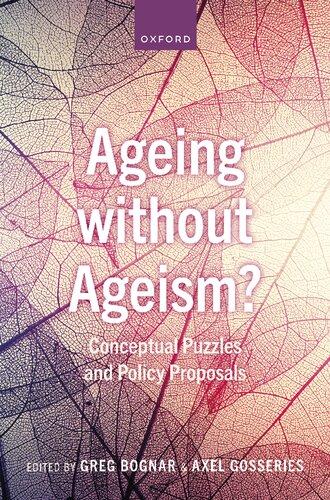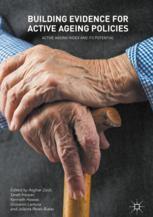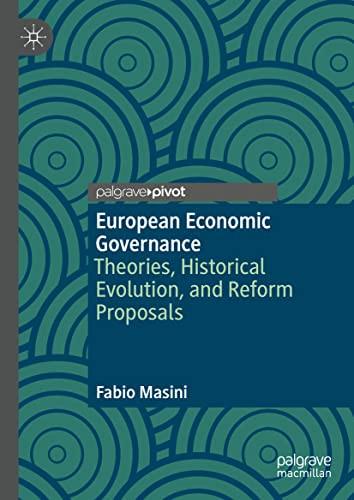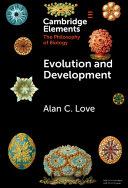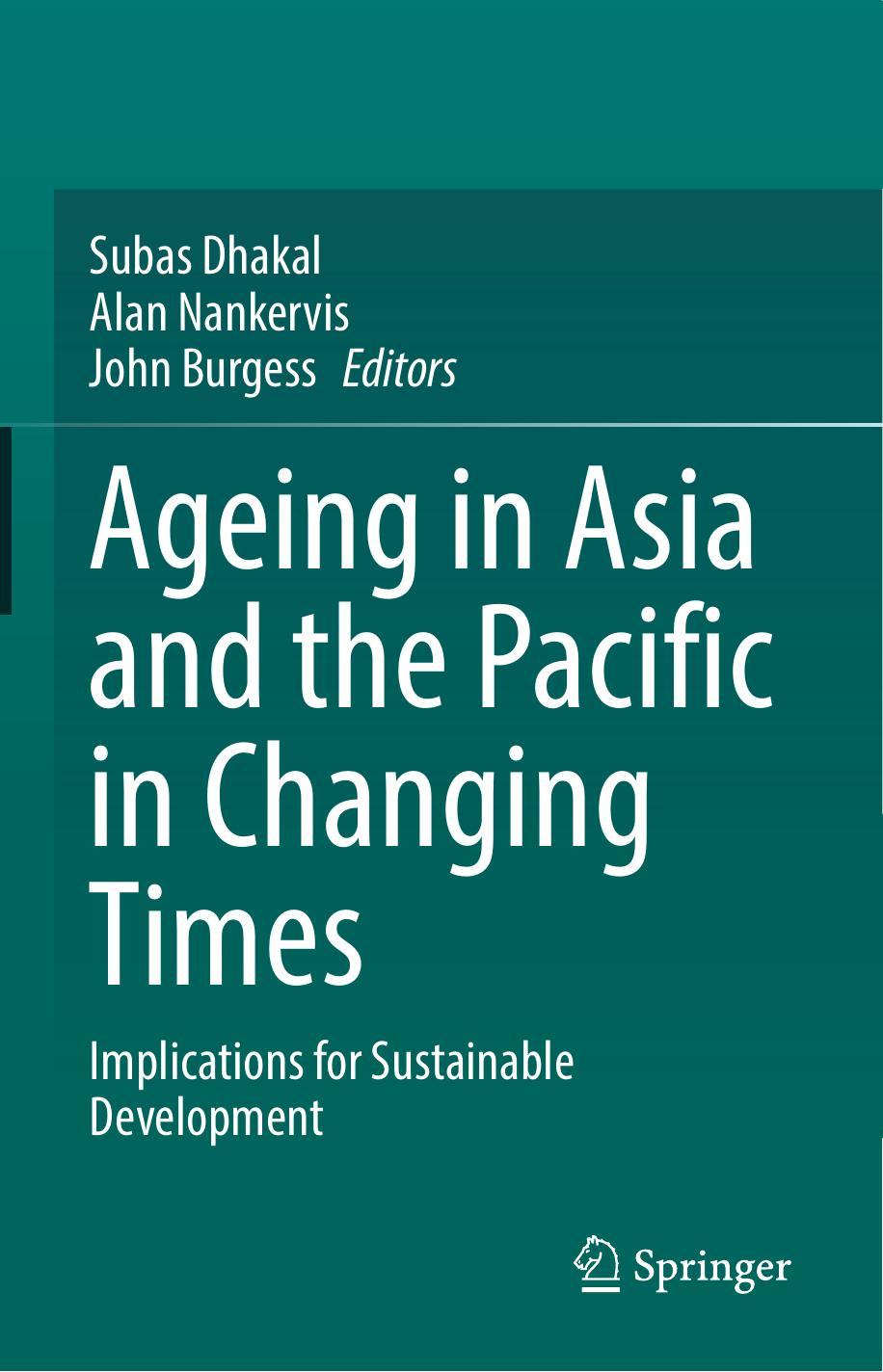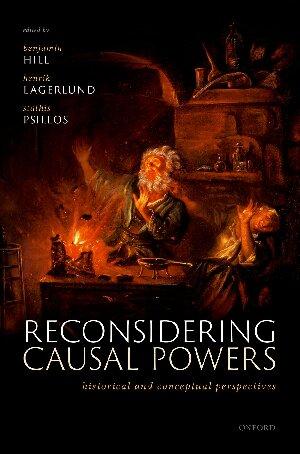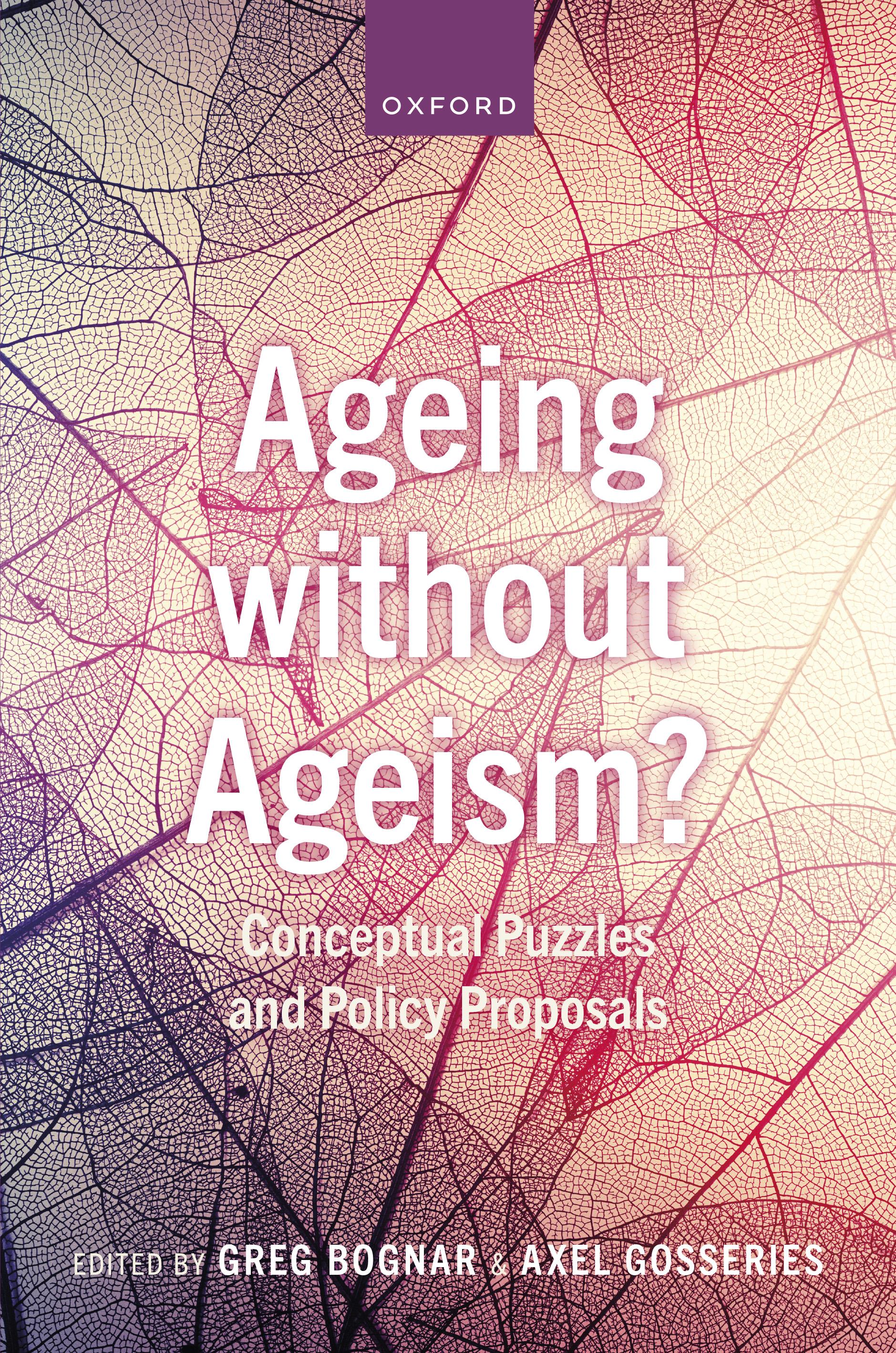Ageing without Ageism? Conceptual Puzzles and Policy Proposals Greg Bognar (Editor) Visit to download the full and correct content document: https://ebookmass.com/product/ageing-without-ageism-conceptual-puzzles-and-polic y-proposals-greg-bognar-editor/
More products digital (pdf, epub, mobi) instant download maybe you interests ...
Building Evidence for Active Ageing Policies: Active Ageing Index and its Potential 1st Edition Asghar Zaidi
https://ebookmass.com/product/building-evidence-for-activeageing-policies-active-ageing-index-and-its-potential-1stedition-asghar-zaidi/
European Economic Governance: Theories, Historical Evolution, and Reform Proposals Fabio Masini
https://ebookmass.com/product/european-economic-governancetheories-historical-evolution-and-reform-proposals-fabio-masini/
Gradual Greg Berman
https://ebookmass.com/product/gradual-greg-berman/
Geographies of Transport and Ageing 1st ed. Edition
Angela Curl
https://ebookmass.com/product/geographies-of-transport-andageing-1st-ed-edition-angela-curl/
Evolution and Development: Conceptual Issues Alan C. Love
https://ebookmass.com/product/evolution-and-developmentconceptual-issues-alan-c-love/
Ageing in Irish Writing 1st ed. Edition Heather Ingman
https://ebookmass.com/product/ageing-in-irish-writing-1st-ededition-heather-ingman/
Annelida 1st Edition Greg Rouse
https://ebookmass.com/product/annelida-1st-edition-greg-rouse/
Subas Dhakal Alan Nankervis John Burgess Ageing Asia And The Pacific In Changing Times Implications For Sustainable Development Desconocido
https://ebookmass.com/product/subas-dhakal-alan-nankervis-johnburgess-ageing-asia-and-the-pacific-in-changing-timesimplications-for-sustainable-development-desconocido/
Reconsidering Causal Powers: Historical and Conceptual Perspectives Benjamin Hill
https://ebookmass.com/product/reconsidering-causal-powershistorical-and-conceptual-perspectives-benjamin-hill/
Ageing withoutAgeism? Ageing withoutAgeism? ConceptualPuzzlesandPolicyProposals Editedby GregBognar & AxelGosseries
GreatClarendonStreet,Oxford,OX26DP, UnitedKingdom
OxfordUniversityPressisadepartmentoftheUniversityofOxford. ItfurtherstheUniversity’sobjectiveofexcellenceinresearch,scholarship, andeducationbypublishingworldwide.Oxfordisaregisteredtrademarkof OxfordUniversityPressintheUKandincertainothercountries ©theseveralcontributors2023
Themoralrightsoftheauthorshavebeenasserted Allrightsreserved.Nopartofthispublicationmaybereproduced,storedin aretrievalsystem,ortransmitted,inanyformorbyanymeans,withoutthe priorpermissioninwritingofOxfordUniversityPress,orasexpresslypermitted bylaw,bylicenceorundertermsagreedwiththeappropriatereprographics rightsorganization.Enquiriesconcerningreproductionoutsidethescopeofthe aboveshouldbesenttotheRightsDepartment,OxfordUniversityPress,atthe addressabove
Youmustnotcirculatethisworkinanyotherform andyoumustimposethissameconditiononanyacquirer
PublishedintheUnitedStatesofAmericabyOxfordUniversityPress 198MadisonAvenue,NewYork,NY10016,UnitedStatesofAmerica
BritishLibraryCataloguinginPublicationData Dataavailable
LibraryofCongressControlNumber:2022951043
ISBN978–0–19–289409–0
DOI:10.1093/oso/9780192894090.001.0001
Printedandboundby CPIGroup(UK)Ltd,Croydon,CR04YY
LinkstothirdpartywebsitesareprovidedbyOxfordingoodfaithand forinformationonly.Oxforddisclaimsanyresponsibilityforthematerials containedinanythirdpartywebsitereferencedinthiswork.
Acknowledgements Weareextremelygratefultocolleagueswhoacceptedtoserveasrefereesfor thechaptersofthisvolume,includingPaulaGobbi,SorenFlinchMitgaard,Holly Lawford-Smith,KasperLippert-Rasmussen,JeffreyMoriarty,PedroPitaBarros, DanielSabbagh,NenadStojanovic,JamesTaylor,Pierre-EtienneVandamme,and FabioWaltenberg.ManythanksalsogotoDominicByattatOxfordUniversityPress forhissupportthroughoutthepreparationofthisbookandtotheOUPrefereesfor theirveryusefulinsightsonourinitialproposal.
TheeditorswouldliketoacknowledgethefinancialsupportoftheGrantAgency oftheCzechAcademyofSciencesthroughaprojecton‘TakingAgeDiscrimination Seriously’(grantID:17-26629S,PI:AxelGosseries)awardedtotheInstituteofState andLawoftheAcademyofSciencesoftheCzechRepublic,CentreforLawandPublic Affairs(CeLAPA),createdundersubsidiesforalong-termconceptualdevelopment (RVO:68378122).
PARTI. CONCEPTUALPUZZLES 1.AgeDiscrimination:IsItSpecial?IsItWrong?
KatharinaBerndtRasmussen
2.DoestheBadnessofDisabilityDifferfromthatofOldAge?
KasperLippert-Rasmussen
3.InDefenceofAge-DifferentiatedPaternalism
VikiMøllerLyngbyPedersen
4.AgeandtheSocialValueofRiskReduction:ThreePerspectives
MatthewD.Adler
5.CanEgalitariansJustifySpendingMoreontheElderly?
PaulBou-Habib
AxelGosseries
SimonBirnbaumandKennethNelson
PARTII. POLICYPROPOSALS 8.‘LetThemBeChildren?’:AgeLimitsinVotingand ConceptionsofChildhood
AncaGheaus 9.AgeandtheVoting–DrivingAnalogy
TylerM.John
FrancescaMinerva
13.AnEducationResourceAccountforEarlySchoolLeavers
Andrée-AnneCormierandHarryBrighouse
14.DifferentiatingRetirementAgetoCompensatefor HealthandLongevityInequality?
VincentVandenberghe
15.AgeinginPlaceandAutonomy:Isthe‘Age-Friendly’City InitiativeTooElderly-Friendly?
16.AnAge-BasedDelayedHousingWealthTax
18.AnAge-DifferentiatedTaxonBequests
PierrePestieauandGregoryPonthiere
ListofFigures 4.1Aprioritariantransformationfunction
7.1Age-relatedprofilesofsocialinsuranceincomereplacement(countrygroup averages1990–2015)
7.2Age-balanceofincomereplacementinsocialinsurancebytypeofgenerational welfarecontractin18OECDcountries,1990–2015
7.3Incomereplacementinsocialinsuranceforthreeage-relatedsocialrisksin Japan,Norway,andSweden,1960–2015
14.1Differentiatedretirementagesequalizing(expected)illhealthacrossand withincountries
14.2Difficultyofdifferentiatingexpost(importanceoftype-Eandtype-Ferrors). Thecaseoflow-educatedversushighlyeducatedfemalesaged55–65in Germany(DEU),France(FRA),Belgium(BEL),andPoland(POL)
17.1Standardandproposeddistributionofincome(fullline)andtaxrates(dotted line)
ListofTables 1.1Fourformsofdiscriminationwithage-relatedexamples
4.2Utilitarianvalueofincrease∆p incurrent-yearsurvivalprobability(relativeto utilitarianvalueofthatincreasefor80-year-old,low-incomegroup)
4.3CBAvalueofincrease∆p incurrent-yearsurvivalprobability(relativetoCBA valueofthatincreasefor80-year-old,low-incomegroup)
4.4Prioritarianvalueofincrease∆p incurrent-yearsurvivalprobability(relative toprioritarianvalueofthatincreasefor80-year-old,low-incomegroup)
4.8Prioritariansocialvalueofvaccination
7.1Typeofgenerationalprofileinage-relatedsocialinsuranceandselected outcomesin18OECDcountries
7.A1Variablesincludedintheempiricalanalyses:Childhoodriskcategoryby country,averagesfortheperiod1990–2015
7.A2Variablesincludedintheempiricalanalyses:Workingageriskcategoryby country,averagesfortheperiod1990–2015
7.A3Variablesincludedintheempiricalanalyses:Oldageriskcategorybycountry, averagesfortheperiod1990–2015
14.3Differentiatedretirementagesequalizingillhealth(internationalreference= 67):Between-andwithin-countrydifferentiation
ListofContributors MatthewD.Adler, RichardA.Horvitz ProfessorofLawandProfessorof Economics,Philosophy,andPublicPolicy, DukeUniversity
KimAngell, DepartmentofPhilosophy, UiTTheArcticUniversityofNorway
KatharinaBerndtRasmussen, Department ofPhilosophy,StockholmUniversity,and InstituteforFuturesStudies
SimonBirnbaum, DepartmentofPolitical Science,SödertörnUniversity
GregBognar, DepartmentofPhilosophy, StockholmUniversity
PaulBou-Habib, Departmentof Government,UniversityofEssex
HarryBrighouse, Departmentof Philosophy,UniversityofWisconsin, Madison
Andrée-AnneCormier, Departmentof Philosophy,YorkUniversity,Glendon College
AncaGheaus, DepartmentofPolitical Science,CentralEuropeanUniversity
AxelGosseries, FondsdelaRecherche Scientifique(FNRS)andHooverChairin EconomicandSocialEthics,Universityof Louvain(UCLouvain)
DanielHalliday, SchoolofHistoricaland PhilosophicalStudies,Universityof Melbourne
TylerM.John, DepartmentofPhilosophy, RutgersUniversity,NewBrunswick
KasperLippert-Rasmussen, Centreforthe Experimental-PhilosophicalStudyof Discrimination(CEPDISC),Aarhus University,andDepartmentofPhilosophy, UiTTheArcticUniversityofNorway
FrancescaMinerva, Departmentof Philosophy,UniversityofMilan
VikiMøllerLyngbyPedersen, Centrefor theExperimental-PhilosophicalStudyof Discrimination(CEPDISC),Departmentof PoliticalScience,AarhusUniversity
KennethNelson, SwedishInstitutefor SocialResearch(SOFI),Stockholm University
PierrePestieau, UniversitédeLiège;Center forOperationalResearchandEconometrics (CORE,UCLouvain);ParisSchoolof Economics
GregoryPonthiere, HooverChairin EconomicandSocialEthics,Universityof Louvain(UCLouvain)
ManuelSáValente, HooverChairin EconomicandSocialEthicsandSuperior InstituteofPhilosophy,Universityof Louvain(UCLouvain)
VincentVandenberghe, Instituteof EconomicandSocialResearch(IRES), LouvainInstituteofDataAnalysisand ModelinginEconomicsandStatistics (LIDAM),UniversityofLouvain (UCLouvain)
AlexandruVolacu, FacultyofBusinessand Administration,UniversityofBucharest
Introduction GregBognarandAxelGosseries Thisbookaimstocontributetotheessentialandtimelydiscussiononage,ageism, populationageing,andpublicpolicy.Itattemptstodemonstratethebreadthofthe challengesbycoveringawiderangeofpolicyareasfromhealthcaretoold-age support,fromdemocraticparticipationtoeducation,fromfamilytofiscalpolicy. Itbridgesthedistancebetweenacademiaandpubliclifebyputtingintodialogue freshphilosophicalanalysesandnewspecificpolicyproposals.Itapproachesfamiliarissuessuchasagediscrimination,justicebetweenagegroups,anddemocratic participationacrosstheagesfromnovelperspectives.
Oursocietiescontinuetorelyextensivelyonagecriteria,despitethefactthatconcernforagediscriminationisnotnew.TheUSAgeDiscriminationinEmployment Actwasadoptedasfarbackas1967.InEurope,agehasbeenincreasinglyincludedin anti-discriminationlegislationoverthepastseveraldecades.Legalscholars,sociologists,anthropologists,andothersocialscientistshavelongstudiedhowagestructures ourlives.Childrenstudiesandgerontologyarevastandwell-establishedfieldsof scholarship.Yet,withfewexceptions,practicalphilosophershavebeenlessactive thanresearchersfromotherdisciplinesontheagefront.1Thisbookaimsespecially tocontributetofillingthisgap,indialoguewithotherdisciplines.
Twotrendsinparticularrenderthisatimelyexercise.Oneistheongoingprocess ofcriticallyscrutinizingoursocietiesthroughtheprismofrace,gender,disability, andothercategories.Thiscallsforlookingatwhetherageisdifferent—whetherit isuniqueor,asitissometimesput,‘special’fromanormativeperspective.Canthis explainthatittendstogetlessattentionthanothersocialcategories?Shouldweworry lessaboutdifferentialtreatmentongroundsofagethanaboutdifferentialtreatment basedonraceorgender?Andifso,whatarethedifference-makersthatrenderage specialfromanormativeperspective?
Theothertrendthatwarrantsacloserlookatageistheageingofoursocieties. Fifteenyearsago,fewerthan500millionpeoplewere65orolder.In2030,therewill bemorethanonebillionpeopleover65,andby2050,therewillbearound1.5billion.2 Duringthepastdecade,thenumberofolderpeoplesurpassedthenumberofchildren underfiveforthefirsttimeinhumanhistory.3In2015,Japanwastheonlycountry thathadmorethan30percentofitspopulationmadeupbythoseover60;by2050, thiswillbecomethecaseinalldevelopedcountries,includingChina.⁴
1See,e.g. Daniels(1998), McKerlie(2013) or Bidadanure(2021)
2See NationalInstituteonAging,NationalInstitutesofHealth(US)(2007) 3SeeNationalInstituteonAging,NationalInstitutesofHealth(US)andtheWHO(2011). ⁴SeeWHO(2015).
GregBognarandAxelGosseries, Introduction.In: AgeingwithoutAgeism?.EditedbyGregBognar&AxelGosseries,Oxford UniversityPress.©GregBognarandAxelGosseries(2023).DOI:10.1093/oso/9780192894090.003.0001
Populationageingpresentsenormouschallenges.Ageingsocietieswillhaveto makemassiveadjustmentstotheirold-agesupportandhealthcaresystems,their labourmarkets,andtheirsocialandpoliticalinstitutions.Populationageingwillhave profoundeffectsonfamilylife,thenatureofwork,politics,andpeople’slifeplans. Withnohistoricalexperiencetorelyon,societieswillhavetotryuntested,novel, andcreativewaysforcopingwiththechallengesofageing.Andtheymustbeableto provideethicaljustificationsfortheirchoices.
Ouraimistoprovideamultidisciplinarydiscussion,withcontributionsespecially fromphilosophybutalsoinputsfrompoliticalscience,economics,sociology,and otherareas.Inordertoimposesomeorderonawide-rangingcollectionoftopics,we dividedthebookintotwoparts.ThechaptersinPartIpresentin-depthdiscussions ofconceptualandnormativeissues.ThechaptersinPartIIdefendspecificpolicy proposals,groundedinexplicitnormativearguments.Readersinterestedinconceptualissuescanbeginatthebeginning;readersmoreinterestedinpolicyalternatives canpickoneofthechaptersfromPartIIastheirentrypoint.Tohelporientation,we provideseparateoverviewsofthetwopartsbelow.
1.OverviewofPartI PartIdepartsfromthefundamentalnormativequestionaboutage.Isunequaltreatmentonthebasisofagepermissible?Howdoesitdiffer,fromanethicalpointofview, fromotherformsofdifferentialtreatment?Agediscriminationhasbeenaneglected areaintheliteratureonwrongfuldiscriminationinphilosophyandlegaltheory.The firstthreechaptersaimtofillsomeofthegapsbyapproachingthefundamentalnormativequestionfromdifferentdirections.Whatdodifferenttheoriesofwrongful discriminationhavetosayaboutthewrongnessofagediscriminationspecifically? Howisagediscriminationconnectedtodisabilitydiscrimination?Howshouldwe thinkaboutthelinkbetweenpaternalismandage?
IntheopeningchapterofPartI(‘AgeDiscrimination:IsItSpecial?IsItWrong?’), KatharinaBerndtRasmussenexaminesthemoralityofagediscriminationbybringingtogetherphilosophicaltheoriesofwrongfuldiscriminationandaccountsofthe ‘specialness’ofage—thatis,defencesoftheclaimthatthereisamoraldifference betweendiscriminationonthebasisofageanddiscriminationonothergroundssuch asgenderorrace.Afterprovidinganoverviewofconsiderationsthatmightmake agespecial,BerndtRasmussenoffersataxonomyofdifferentformsofagediscriminationandrelatesthemtothreetheoriesofwrongfuldiscrimination.Shefindsthat thesethreetheoriesdifferwithrespecttotheirmoralassessmentofvariousforms ofagediscriminationduetothedifferentrolesthat‘specialness’considerationsplay ineach.Ratherthanarguingforanyparticulartheory,however,BerndtRasmussen concludesbyofferingatemplateforidentifying,analysing,andmorallyevaluating differentformsofagediscrimination.
Inthesecondchapter,KasperLippert-Rasmussencomparesagediscrimination anddisabilitydiscrimination(‘DoestheBadnessofDisabilityDifferfromthatofOld Age?’).Hebeginswithafamiliarquestionfromthephilosophyofdisability:tothe extentthatbeing disabled isworsethanbeingnon-disabled,isthislargelybecauseof factorsthatareindependentofthesocialenvironment(the‘disabilityasbaddifference’view)orlargelybecauseofthe(ableist)natureofthesocialenvironment(the ‘disabilityasmeredifference’view)?Correspondingly,wemightask,totheextent thatbeing old isworsethanbeingyoung,isthislargelybecauseoffactorsthatare independentofthesocialenvironmentorlargelybecauseofthe(ageist)natureofthe socialenvironment?Aretheanswerstothesequestionsrelated?Iftheyare,how?
Lippert-Rasmussenconsiderswhether,ifweareinclinedtoaccepttheviewthat thedisadvantagesofdisabilityarelargelycausedbyanableistsocialenvironment, weshouldalsoaccepttheviewthatthedisadvantagesofoldagearelargelycausedby anageistsocialenvironment.Hethinksweshould.ButLippert-Rasmussenargues thattheviewthatageistsocialenvironmentsareprimarilyresponsibleforthedisadvantagesofoldageshouldberejected.Therefore,weshouldalsorejecttheview thatableistsocialenvironmentsareprimarilyresponsibleforthedisadvantagesof disability.Yet,whileinsistingthatourviewsondisabilityconstrainthoseweadopt onage,Lippert-Rasmussenalsostressesthatweshouldnotoverstatetheimportanceoftakingastanceonthemere-differenceandbad-differencedivide.Rather, weshouldpaymoreattentiontothe specificways oldageanddisabilitycausedisadvantageinsteadoftryingtodefendbroadgeneralizationsaboutwhatfamilyofcauses predominates.
Thethirdchapterexaminesagediscriminationfromtheperspectiveofagedifferentiatedpaternalism.Manyofussharetheintuitionthatpaternalismisless problematicwhenappliedtochildrenratherthantotheelderly.OneinterestofViki MøllerLyngbyPedersen’schapter,‘InDefenceofAge-DifferentiatedPaternalism’,is thatshestressesthatweneedtoconsidernotonlythedimensionsofcompetenceand voluntarinessbutalsothemagnitudeofthegoodpromotedbypaternalisticinterventions.Whilethisdualaccountdoesnotgenerallychallengecommon-senseintuitions aboutpaternalism,itintroducesadditionalcomplexitywhenevaluatingpaternalistic interventionsinawiderangeofcases.Thechapterconsidersmanyexamples,from age-differentiatedrulesforaccesstosterilization,throughage-differentiatedfinesfor notusingahelmet,toage-differentiatedpricesforcigarettes.Readersespeciallyinterestedintheseissuesmayalsowanttotakealookat Chapter8 (onpaternalismand conceptionsofchildhood), Chapter12 (onpaternalisminassistedreproductionand socialfreezing),or Chapter13 (onanti-paternalismincompulsoryeducation).
TheremainingchaptersinPartItakeupissuesofdistributivejustice.Theyconsidertheconnectionbetweenageanddifferentmethodsofpolicyevaluation.They examinetheroleofageinegalitariantheoriesofdistributivejustice.Theyaskwhether itisjustifiedthatmodernwelfarestatesspendmoreontheelderlythanonotherage groups,exploretheimplicationsoftheideathatprinciplesofdistributiveequality
shouldapplytowholelivesratherthanparticularsegments(orstages)inlife,and defendtheviewthatsocialinsurancesystemsshouldbeage-balanced,offering similarlevelsofincomereplacementacrossage-relatedsocialrisks.
In‘AgeandtheSocialValueofRiskReduction:ThreePerspectives’,MatthewD. Adlercomparesthreeframeworksofpolicyanalysisfromtheperspectiveoffatality riskreductionfordifferentagegroups.Dotheyimplythatthevalueofriskreduction dependsonage—andhowdotheyrelateagetootherfactors?Thethreeframeworks areutilitarianism,prioritarianism,andcost–benefitanalysis.
Adlerfindsthatthevalueofriskreductiondecreaseswithagebutincreaseswith incomeaccordingtoutilitarianism.Itdecreasesevenmoresharplywithageaccordingtoprioritarianism,butprioritarianismcanalsoneutralizetheeffectofincome. Andforcost–benefitanalysis,thevalueofriskreductionincreaseswithincomeeven moresharplythanforutilitarianism,whileitfirstincreasesandthandecreaseswith increasingage.Noneoftheframeworks,therefore,isneutralwithrespecttoage.They valuefatalityriskreductiondifferentlydependingonaperson’sage(andincome). Prioritarianismistheonlyapproachthatcanneutralizetheeffectofincomeandput highervalueofreducingriskstotheyoung.Thatmaybeanattractivefeature.
PaulBou-Habib,inhischapter‘CanEgalitariansJustifySpendingMoreonthe Elderly?’,takesanegalitarianapproachtoageandfairdistribution.Hearguesthat thefactthatmodernwelfarestatesdevoteadisproportionateamountoftheirbudget totheneedsoftheelderlyraisesapuzzle.Peoplewhoreacholdageareoften,onthe whole,morefortunatethanthosewhodon’tbecausetheyhaveenjoyedalongerlife. Indevotingdisproportionateexpendituretowardstheirneeds,thewelfarestatethus appearstobeprivilegingtheneedsofthosewhoaremorefortunatethanothers.
Bou-Habibexaminestheresponsetothispuzzleprovidedbyrelationalegalitarians(whoholdthatweshouldcarenotonlyabouthowthewelfarestatedistributes resourcesbetweenpersonsbutalsoaboutwhetheritprotectspeoplefrommistreatmentbyothers).Relationalegalitariansjustifydisproportionateexpenditureonthe elderlyonthegroundsthatitisnecessarytoprotectthemagainstdominationand marginalization,amongotherformsofmistreatment.ButBou-Habibfindsthatthe relationalegalitarianresponsedoesnotsolvethepuzzle.Heproposesadifferentsolution,basedontwoclaims.First,sufferingisintrinsicallybadandshouldbeprevented, evenwhenitisexperiencedbypersonswhoaremorefortunatethanothers.Second, disproportionateexpenditureontheneedsoftheelderlyisaformofinsurancethat allpersonswouldhavepurchasedinfaircircumstances.
Inhischapter,‘AgeLimitsandtheSignificanceofEntire-LivesEgalitarianism’, AxelGosseriesfocusesontheclaimthatprinciplesofdistributivejusticeshouldbe appliedtowholelives—thatis,todeterminewhatweowetopeopleasamatteroffair distribution,weneedtoconsiderhowtheyfareduringtheirentirelives.Gosseries providesanoverviewoftheentirelifeviewandexploresitspossibleunderlyingintuitions.Heseparatesadefensiveversionoftheview(whicharguesthatsomeagelimits arenotobjectionable)fromanaffirmativeone(whicharguesthatsomeagelimitsare actuallydesirable).Heconcludesthatwhileagelimitstendtoprovideoneofthebest illustrationsofthepracticalrelevanceofthe‘entirelife’debate,thelatterdoesnot
necessarilyofferusinsightsthatareassignificantasexpectedtodefendagelimits overtheirwholerange.
PartIcloseswithamoreempiricallyorientatedchapter.Itstartswiththeobservationthatwelfarestatesdiffergreatlyintheextenttowhichtheyprovidesocial protectionforvariousage-relatedsocialrisks.Theysetdifferentprioritiesbetween needsassociatedwithchildhood,maturity,andoldage.In‘AgeUniversalismwill BenefitAll(Ages)’,SimonBirnbaumandKennethNelsonexploreanddefendthe idealofageuniversalisminsocialinsurance,accordingtowhichthedegreeofincome replacementshouldbesimilaracrossage-relatedsocialrisks.Theargumentsuggests pragmaticadvantagesofage-balancedsocialinsurance,showingthatittendstoprovidehigherlevelsofincomereplacementforage-relatedrisksthroughoutthelife cycleandachievemorefavourablesocialoutcomesinallagegroupswithrespectto povertyrates,trust,andsubjectivewell-being.
2.OverviewofPartII ThechaptersinPartIIhaveamorepolicy-orientedfocus.Theycoverarangeoftopicsfromdifferentperspectives.Thetopicsincludepoliticalparticipation,education, healthcare,retirement,andold-agesocialservicesaswellastaxationandinheritance.
Thefirstclusterofchaptersisonpoliticalparticipationandvotingrights.The chaptersaddresswhetherandhowdisenfranchisingtheyoungcanbejustifiedon thebasisofdifferentconceptionsofchildhood,whetherthevoting–drivinganalogy canjustifydisenfranchisingtheold,andwhethergivingextraweighttotheyoung inpoliticaldecision-makingcanbeaplausibleavenuetoaddressingconcernsabout politicalshort-termism.
Inthefirstchapter,‘“LetThemBeChildren”?AgeLimitsinVotingandConceptionsofChildhood’,AncaGheausexploresalternativeviewsaboutthenatureand valueofchildhoodandtheirrelevancetotheissueofchildren’svotingrights.Inparticular,shecontrastsoneviewthatregardschildhoodasameredeficiencyandas preparationtimeforadulthoodwithafamilyofviewsthatemphasizesthevalueof goodsuniquetochildhood,suchasplayfulnessandcarefreeness.Defendersofdeficiencyviewstendtoassumethatthelackofagencyisanunqualifiedbadforchildren andneglectwaysinwhichchildhoodallowsaccesstoothersourcesofvalue.
Gheausmapsouthowthedifferentaccountsbearonargumentsforandagainst enfranchisingchildren.Shealsoexplainswhychildrenwholiveinasocietyin whichmanyadultsfailtocomplywiththeirdutiesofintergenerationaljusticehave aweightierinterestinvotingandhencewhythecaseforchildren’senfranchisement isstrongerinsuchcircumstances.
Thenextchaptercontinuestoexplorepoliticalparticipationbylookingatthe otherendoflife.Shouldtherebeanagelimitsuchthatpeople over itlosetheireligibilitytovote?Afterall,lossofabilityisoftenusedtojustifyrestrictingpeople’s freedom.Forinstance,age-relatedlossofabilityisusedtojustifytherequirement ofperiodicrenewalofdrivinglicencesandcouldresultinthelossofdrivingpermit
fortheelderly,limitingtheirfreedomofmovement.Cantherebeananalogouscase forvoting?In‘AgeandtheVoting–DrivingAnalogy’,AlexandruVolacuasksthis question.Heexaminesargumentsbyanalogyingeneralandformulatessuchanargumentlinkingdrivingandvoting.Heconsidersdifferentwaystheargumentcouldbe appliedtoage-adjustedvotingrights.However,intheend,hefindsthattherearesignificantdissimilaritiesbetweendrivingandvoting.Thus,Volacuconcludesthatthe argumentisunsuccessful.
In‘EmpoweringFuturePeoplebyEmpoweringtheYoung?’,TylerM.Johnargues thatthestateisplaguedwithproblemsofpoliticalshort-termism:excessivepriority giventonear-termbenefitsattheexpenseofbenefitsfurtherinthefuture.Political scientistsandeconomistsreckonthatpoliticalleadersrarelylookbeyondthenext 2–5years,exacerbatingproblemssuchasclimatechangeandpandemics.Whatcan bedonetocounterthis?Onepossiblemechanisminvolvesapportioninggreaterrelativepoliticalinfluencetotheyoung.Theideaisthatyoungercitizensgenerallyhave greateradditionallifeexpectancythanoldercitizens,andthusitlooksreasonableto expectthattheyhavepreferencesthatareextendedfurtherintothefuture.Ifwegive greaterrelativepoliticalinfluencetotheyoung,ourpoliticalsystemmightexhibit greaterconcernforthefuture.
ButJohnshowsthatgivinggreaterpoliticalpowertotheyoungisunlikelyin itselftomakestatessignificantlylessshort-termist:noempiricalrelationshiphas beenfoundbetweenageandwillingnesstosupportlong-termistpolicies.Instead,he proposesamorepromisingage-basedmechanism.Statesshoulddevelopyouthcitizens’assembliesthatensureaccountabilitytofuturegenerationsthroughaschemeof retrospectiveaccountability.Policymakerswouldberewardedinthefutureinproportiontotheeffectsoftheirpoliciesonthelongrun.Thiswouldincentivizethem nowtochoosepoliciesthathavethebestlong-termconsequences.
ThesecondcoupleofchaptersinPartIIareonhealthcare.ThefirstisGregBognar’schapteron‘COVID-19,Age,andRationing’.DuringtheCOVID-19pandemic, somehospitalsfoundthemselvesshortofventilators,intensivecareunit(ICU)beds, andqualifiedmedicalpersonneltotakecareofpatients.Physicianshadtomake difficult,life-and-deathchoices.Theywereaidedbyvariousguidelinesandrecommendationsissuedbygovernmentsandmedicalassociations.Bognarreviewssome oftheseguidelines,lookinginparticularattheroleofageandlifeexpectancyascriteriafortherationingofhealthcareresources.Hedefendstheviewthattheethical aimoftriageshouldbetomaximizebenefitsandconcludesthatwhileneitherage norlifeexpectancyshouldbeusedtocategoricallyexcludepatients,bothmayhave aroleintriagebyvirtueoftheirconnectiontocapacitytobenefit.
FrancescaMinerva’schapter,‘AgeisminAssistedReproduction’,beginsfromthe factthatfemalefertilitydeclinesatamuchfasterratethanmalefertility.While,inthe pastdecades,assistedreproductiontreatments(ARTs)havedramaticallyincreased women’schancesofgettingpregnantovertheageof35,itremainsverydifficultfor womenabovetheirmid-40stogetpregnant,giventhatARTsuccessratesdecrease withincreasingage.Moreover,manyEuropeancountrieslegallypreventwomenover theageof45fromaccessingARTs.
MinervaopposesupperagelimitsonARTsforwomen,rejectingthreearguments thatarebased,respectively,onpaternalism(toprotectthemother’shealth),thelink betweenageandincreasedriskofabnormalitiesforthechild,andthediminished abilityofolderparentstotakecareofchildren.Shealsocallsforamorepro-active policy,includingfreeaccesstosocialfreezingandinvestmentinresearchintoways ofdelayingmenopause.
Inthefollowingchapter,Andrée-AnneCormierandHarryBrighousepropose‘An EducationResourceAccountforEarlySchoolLeavers’.Theyarguethatschoolshould ceasetobecompulsoryatage16andthataneducationresourceaccount(ERA) shouldbeestablishedforstudentswholeaveschoolatthatage.TheERAwouldbe sufficienttocoverthreeyearsoffull-timeeducation.Itcouldbelinkedtoinflation andearlyschoolleaverscoulduseitinaccreditednon-profiteducationalinstitutions atanylaterpointintheirlives.
Twosetsofargumentssupporttheirproposal.Thefirst,buildingontheempiricalliterature,focusesonefficiencyandhighlightstheadvantagesofanERAwith respecttothe‘disruptive’studentsissueinparticular.Thesecondsetofargumentsis anti-paternalistic.CormierandBrighousedistinguishthreeanti-paternalisticarguments:theviewthatindividualsarethebestjudgesoftheirownwelfare(also discussedin Chapter3),theideathatautonomousdecision-makingisacomponentofwell-being,andarespect-basedviewofwhatrendersanti-paternalism wrong.Whiletheyendorsethelattertwoarguments,theirERAproposalstillhas amildlypaternalisticdimensionsinceitsfundscanonlybeusedforeducation purposes.
VincentVandenberghetakesuptheissueofretirementin‘DifferentiatingRetirementAgetoCompensateforHealthandLongevityInequality’.Ashepointsout, usuallyauniformageisusedtoproxyworkcapacitylossandtriggerthepayment ofpensions.Recently,however,somehavearguedthatweneedseveralretirement agestobettermatchthedistributionofwork(in)capacityacrosssocio-demographic groups.Atfirstsight,thisproposalmakesperfectsense.Workcapacitydeclines fasteramonglow-incomeandlow-educatedindividuals.Butthereisalsoalotof unaccountedheterogeneityeveninsidenarrowlydefinedsocio-economicgroups. Andthiscompromisesthefeasibilityanddesirabilityofretirement-agedifferentiation.Underaregimeofsystematicretirement-agedifferentiation,therewouldbe manysituationswithnoretirementforpeoplewithseriousworkrestrictionsand, simultaneously,numerouscaseswhereentirelyhealthypeopleenjoyretirement.An alternativeapproachwouldbetosticktoauniformretirementage,backedupbya reinforceddisabilityscheme.
OldagealsotakescentrestageinKimAngell’s‘AgeinginPlaceandAutonomy:Is the“Age-Friendly”CityInitiativeTooElderly-Friendly?’Angellisconcernedwiththe ‘age-friendlycities’initiativeaimedatenhancingpeople’sopportunitytoageinplace. Hepresentsanautonomy-baseddefenceoftheideaandexaminesthemoralclaim thattheelderlycanmakeinsupportoftheirabilitytoageinplace.Heemphasizes, amongotherconsiderations,thatageinginplacecanhavecognitivebenefitsthrough theroutinesandhabitsmadepossiblebyfamiliarenvironments.
Heargues,however,thattheclaimsoftheelderlycancomeintoconflictwiththe claimsoftheyoung.Weshouldnotonlylookattoday’selderlybutalsoanticipatehow today’syoungwillfarewhentheygetold.Angellappealstothecohort-specificpredictionsbytheOrganisationforEconomicCo-operationandDevelopment(OECD)— suchthat,forexample,today’syoungareexpectedtobeworseoffwhenoldthanthe currentlyold—tomakethecaseforan‘all-age-friendly’(oreven‘young-friendly’) interpretationoftheage-friendlycitiesinitiative,whilealsoinsistingontheimportanceofpoliciesbenefitinglow-incomefamilies(regardlessofage)andpromoting intergenerationalhousinginitiatives.
Thelastclusterofchaptersinthebookfocusesonageandtaxation,looking respectivelyathousing,income,andbequests.
Inhischapter,‘AnAge-BasedDelayedHousingWealthTax’,DanielHalliday considerstaxationandhousingwealth.Popularnarrativesaroundageingandintergenerationalinequalitysuggestthatyoungpeopleincreasinglytendtosubsidizeolder peopleinspiteofenjoyingpoorereconomicprospects.Onespecificconcernisthat olderandyoungerbirthcohortsareunequallysituatedwithrespecttothedistributionofhousingwealthaswellasthedistributionofthetaxburden.Hallidayaddresses thisconcernbyproposinganage-baseddelayedhousingwealthtax.Theideaisthat oncehomeownersreachacertainage,theyarechargedsomeportionoftheirhome’s valueonanannualbasis,whichwouldeventuallybepaidtothetaxofficeuponthe deathofthesurvivingspouse.Thistaxcanbeavoidedbydownsizingtoahome oflesservalueandtherebyfreeinguphousingtobepurchasedbyyoungerpeople. Retainingavaluablehomemeans,instead,incurringataxliabilitythatcanbeusedto fundthebenefitsconsumedbyretirees.Adelayedhousingwealthtaxcanbedesigned toaccommodatevariablessuchascoupleswhodifferinageorsingleretiredhomeowners.Hallidayarguesthathisproposalcomparesfavourablywithalternatives,such asinheritancetaxation,forgettingolderpeopletoabsorbthecostsoftheircare.Just asinthepreviouschapter,accesstohousingfortheyoungisacentralconcern.
Inhischapter,ManuelSáValentedistinguishesbetween‘TwoTypesofAgeSensitiveTaxation’.Oneisaformofcumulativeincometaxationwhichtaxesannual income,takingintoaccountallearlierincomeyearsinsteadofjustthelastone.The otherisanexplicitlyage-differentiatedschemethattaxesannualincomeadjusted byaratethatdependsonthetaxpayer’sage.Thechapterfirstpresentsreasons tosupportcumulativeincometaxationandexamineshowitwouldaffectfiscal obligationsacrosslife.Then,itarguesthatmaximinegalitarians—thatis,egalitarians whogiveabsoluteprioritytoimprovingthesituationoftheleastwelloff—should aimatahump-shapedtaxrateacrosspeople’slives.Sucharatereflectsaconcern aboutbothearlydeathandpovertyinoldage,hencefocusingontheyoungand theelderly,notthemiddle-aged.Thechapterquestionswhethercumulativeincome taxescandeliverthisresultwithoutresortingtoexplicitlyage-differentiatedtaxes.It reachestheconclusionthatwhilecumulativeincometaxationcanbenefittheyoung (includingtheshort-livedamongthem),age-differentiatedtaxesarenecessaryto protecttheelderlypoor.
Inthefinalchapter,PierrePestieauandGregoryPonthierepresentfourargumentssupporting‘AnAge-DifferentiatedTaxonBequests’—thatis,ataxrateon
inheritancethatvarieswiththeageofthedeceased.Theargumentsarebasedon differentethicalfoundationsandleadtoaninheritancetaxthatcaneitherincrease ordecreasewiththeageofthedeceased.PestieauandPonthieremakethecaseforan age-differentiatedtaxbasedontheideaofcompensatingunluckyprematurelydead persons.Theirviewsupportsabequesttaxthatincreaseswiththeageofthedeceased. AlongwithChapters5and17,theirchapterillustratesthemanynormativeproblems thatdifferentiallongevityraises. ∗∗∗
Together,thesechaptersprovideuswithasenseofthecomplexityoftheissuesat stake.Theaccountweacceptaboutthewrongnessofdiscriminationmakesadifferencetowhichage-basedpoliciescanbedefended.Sodoestheviewofpaternalism wetakeand,moregenerally,thebackgroundtheoryofjusticeweendorse.Itmatterswhetherweconsiderdifferentiallongevityunfair,whetherweareconcerned withequalitybetweenentirelivesorpartsoflives,whetherweholdthatdifferentialtreatmentbyageisrelevantlysimilartounequaltreatmentbyrace,gender,or disability.Thejustificationofage-basedpoliciescanbeaffectedbyamultitudeof seeminglyremotenormativecommitmentsandideas.Inaddition,itisinfluencedby empiricalassumptionsaboutageandageing.Severalchaptersinthisbookhavecriticallydiscussedsuchassumptions,includingtheconnectionofagetospecificabilities (forinstance,workingcapacityorpoliticalcompetence),characteristics(forinstance, fertility)ordispositions(forinstance,long-termistpreferences).
Allthissuggeststhatitisprobablywisetorenouncethequestforaunifiedview ofthenormativerelevanceofage.Theroleofageislikelytoremaindifferentindifferentpolicyareasandindifferentpolicieswithinthoseareas.Thismeansthatwe areleftwithseveraltasks.Weshouldkeepcriticallyinvestigatingthedegreetowhich specificage-basedpoliciescanbejustified.Whenwedevelopanddebatenewpolicies,weshouldcontinuouslykeepinmindhowtheyareaffectedbyageandhowthey wouldaffectdifferentagegroups.Weshouldkeepunveilingcommonpatternsofjustificationthatoperateacrossseveraldomainsandthatopposeorsupportage-based practices.Behindallthat,thereisthequestionwhetherthereshouldbeasociety onthehorizoninwhichagelosesitsstructuringfunction:wherepeoplecanwork beforestudying,retirebeforestartingtowork,orhavechildrenwellafterhaving startedtheirprofessionalcareer.Wehopethatthisbookwillcontributetohelping thereaderdecidewhethersuchasocietywouldnotonlybefeasiblebutalso,and moreimportantly,desirable.
References Bidadanure,JulianaUhuru.2021. JusticeAcrossAges:TreatingYoungandOldasEquals. Oxford:OxfordUniversityPress. Daniels,Norman.1998. AmIMyParents’Keeper?AnEssayonJusticebetweentheYoung andtheOld.Oxford:OxfordUniversityPress.
McKerlie,Dennis.2013. JusticebetweentheYoungandtheOld.Oxford:OxfordUniversity Press.
NationalInstituteonAging,NationalInstitutesofHealth(US).2007. WhyPopulationAgingMatters:AGlobalPerspective.Baltimore,MA:NationalInstituteonAging, NationalInstitutesofHealth(US).
NationalInstituteonAging,NationalInstitutesofHealth(US)andtheWHO(World HealthOrganization).2011. GlobalHealthandAgeing.Baltimore,MA:National InstituteonAging,NationalInstitutesofHealth(US)andWHO. WorldHealthOrganization(WHO).2015. WorldReportonAgeingandHealth.Geneva: WorldHealthOrganization.
PARTI CONCEPTUALPUZZLES Age Discrimination IsItSpecial?IsItWrong? KatharinaBerndtRasmussen
1.Introduction
ImagineDanaandEli,twoapplicantsforavacantposition.Whilebotharequalified inallrelevantrespects,neitheriscalledtobeinterviewedforthejobsimplybecause oftheirgender(Danaisfemale)andrace(Eliisblack),respectively.Thesecasesare intuitivelyclearinstancesofdiscriminationandintuitivelymorallywrong.
Theyareclassifiedas groupdiscrimination alsobythefollowingdefinition:1
Anagent(say,anemployer)groupdiscriminatesagainstsomeone(say,anapplicant)ongroundsofpropertyP,bydoingsomething(e.g.,disregardingtheir application)ifandonlyif:
(i)indisregardingtheapplication,theemployertreatstheapplicant worse than shewouldhavetreatedhim,hadhenothadP,orhadshenotbelievedhimto haveP,
(ii)itis because theapplicanthasPorbecausetheemployerbelievesthathehasP, thatshetreatshimworse,and
(iii)Pisthepropertyofbeingamemberofa sociallysalient group,i.e.,agroupperceivedmembershipofwhichisimportanttothestructureofsocialinteractions acrossawiderangeofsocialcontexts.
Beingfemaleandbeingblack,respectively,aresociallysalientpropertiesinmany societies.Clearly,notbeingcalledtobeinterviewedforajobthatoneappliedfor justbecauseofsuchaproperty—whenoneisqualifiedandwouldhavebeencalled hadonelackedtheproperty—amountstobeing treatedworse inatleastoneofthe followingsenses:
(a)beingmadeworseoff(e.g.deprivedofanopportunity),or
1Cf. Lippert-Rasmussen(2014); BerndtRasmussen(2019);andmanyoftheentriesin LippertRasmussen(2017).In legal terms,thisdefinitioncaptures(possiblylegallyacceptable)differential treatmentaswellas(unlawful)discrimination.Onthe moral statusofthesephenomena,seesection4.
KatharinaBerndtRasmussen, AgeDiscrimination.In: AgeingwithoutAgeism?.EditedbyGregBognar&AxelGosseries, OxfordUniversityPress.©KatharinaBerndtRasmussen(2023).DOI:10.1093/oso/9780192894090.003.0002
(b)beingtreatedasinferior(e.g.considerednotworthyofequalconsiderationwith other—maleorwhite—applicants).2
Andarguably,treatingsomeoneworseinatleastoneofthesesensesjustbecauseof theirsociallysalientpropertyisprimafaciemorallywrong.3Hence, ceterisparibus, DanaandEliarewrongfullydiscriminatedagainst.
Now,imagineAlex,Billie,andCharlie,threeequallyqualifiedapplicantsfora vacantposition.Theybelongtothreedifferentbirthcohorts(say,threeconsecutive generations)andthustodifferentagegroups:Alexis60+,Billieis40,andCharlieis under18.WhileBillieiscalledbacktobeinterviewed,theothertwoarenot—simply becauseoftheiroldandyoungage,respectively.
Clearly,beingold(60+)andbeingyoung(under18)aresociallysalientproperties inmanysocietiesand,inthissense,comparabletobeingfemaleandbeingblack. Moreover,innotbeingcalledback,AlexandCharliesufferthesameformofworse treatmentasDanaandEli.Hence,eventheircasesshouldbeclassifiedasdiscriminationbytheabovedefinitionandcountasmorallywrongforthesamereasons.
Writersonagediscrimination,however,suggestthatageis‘special’,thatis,relevantlydifferentfromothergroundsofdiscriminationsuchasgenderorrace.Such specialness,inturn,mighthavemoralramifications,possiblymakingagediscriminationlesssevere,ormorejustifiable,thantheseotherforms.Thespecialnessofage maythustranslateintolessermoralseriousnessofagediscrimination.Ourpractices andintuitionsseemtosupportthisidea:inmanysocieties,itiscommonandcommonlyacceptedthat,forexample,therighttovoteandtorunforofficeisnotgranted tominors,thatcarorlifeinsurancepremiumsareage-adjusted,orthatretirementat acertainagebecomesmandatory.Ontheotherhand,theremightbegoodreasons tochangethesepracticesanddiscounttheseintuitions.
Thischapterexaminesthemoralstatusofagediscriminationbybringingtogether accountsofthewrongnessofdiscriminationwithaccountsofthespecialnessofage. Section 2 summarizesthespecialfeaturesofageandtheirroleindifferentproposals tojustifytheuseofagecriteriaandsuggestsatemplatewithinwhichthesespecialness considerationsbecomerelevant:theargumentfromspecialness.Section 3 explores differentformsofagediscrimination.Section4presentsthreeinfluentialaccountsof thewrongnessofdiscriminationandshowsthatdifferentformsofagediscriminationarecoveredbydifferentwrongnessaccounts.Moreover,Ireturntotheproposals justifyingtheuseofagecriteria,basedonthespecialnessofage,andexploretheroles theycanplayunderthesedifferentaccounts.Section 5 concludes.
2.Specialnessofageandage-basedtreatment Thedebateonagediscriminationlargelyfocuseson chronologicalage,definedas thenumberofyearsfromaperson’sbirthtothegivendate.Chronologicalage
2See BerndtRasmussen(2019)
3Foreaseofexposition,Iswitchbetweentalkingaboutanaction’sbeing primafacie(morally)wrong andtherebeinga primafacie(moral)reason againsttheaction.
(henceforthwithoutthequalifier)hasthreespecialfeatures,ascomparedto,for example,genderorrace:
(a)perfect passage-of-timecorrelation (bydefinition);
(b) highdivisibility:anormallifespancanbepartitionedintomanyalternativeage segmentsofdifferentsizes;and
(c) multiplebelonging:apersonwithanormallifespanwillbelongtoanumberof suchagesegmentsastimepasses.⁴
Akeyideaisthat,becauseofthesespecialfeatures,relyingonagecriteria(e.g.age limits)maysometimesbejustifiedintwodifferentways.First,means–endefficiency: ageisagoodproxy(statisticalindicator)forcertaingiventargetvariablesand,as such,atoolformoreefficientdecision-making.Second,overallbetterness:usingage criterialeadstobetteroveralloutcomes,insomesense.Iwilldiscussthesetwoproposalsinsections 2.1 and 2.2,indicatingwhichspecialnessfeatures(a–c)become relevantatdifferentpointsinthearguments.
2.1Means–endefficiency:Ageas reliable and precise proxy Intypicalemploymentcases,applicantageis‘significantlycorrelated’(Gosseries 2014:63f.)to,forexample,jobqualificationsandexpectedproductivity.Thisis mainlyduetospecialnessfeature(a),passage-of-timecorrelation.
Toillustrate:Charlie,whoisunder18,mostlikelydoesnothaveacollegeoruniversitydegree.Thishastodowiththewayoursocietiesorganizetheireducation systems:ageofentry,sequenceofeducationallevels,numberofyearsrequiredfor adegree,etc.Also,under-18-year-oldsarelikelynottohavethecognitivecapacities requiredforjobswhereriskmanagementiscentral.Thishastodowithtypicalneurological/braindevelopment.Alex,whois60+,islikelytolacksomeofthephysical andcognitiveabilitiesofanapplicantintheirforties,likeBillie,butalsolikelytohave moreexperience-basedcompetences.Thishastodowithprocessesofphysicaland mentaldeclineandwiththetimedimensionoflearningcurves,respectively.
Inamedicalcontext,givenstatisticalfactsaboutlifeexpectancy,agecanworkas aproxyforremaininglifeyears(Cupit2013; Bognar2015).Thus,agecanbeone relevantfactorforallocatingscarcehealthresources,asexemplifiedbytheconcepts ofquality-adjustedlifeyear(QALY),anddisability-adjustedlifeyear(DALY).⁵
Thus,foravarietyofreasons,agecanbeareliableproxyforrelevantindividualtargetvariables.Ofcourse,foranygivenapplicantorpatient,anemployerormedical providermightmakeamoreaccurateassessmentofsuchtargetvariablesbyconductinganindividualassessment.Yet,sincethelattertendtobemoretime-consuming,
⁴Fordiscussionsofthesefeatures,see Macnicol(2006); Cupit(2013); Gosseries(2014); Bidadanure (2016).
⁵See Bickenbach(2016)
complicated,ormorallyproblematic,relyingonagecriteriacanfacilitatedecisionmaking.Thus,topromotemeans–endefficiency,theremaybereasonstouseage criteria.
Justifyingagecriteriabyreferencetomeans–endefficiencyalsoreliesonspecialnessfeature(b),highdivisibility.Sinceanormallifespanisdivisibleintoanysetof agesegmentsthatarerelevantinagivencontext,usingagecriteriapotentiallyallows forhigherlevelsof‘precision’(Gosseries2014:63f.;cf. Bidadanure2016)inapproximatingtherelevanttargetvariables,comparedto,forexample,genderandrace. Usingmore precise agecriteriaallowsforincreasedmeans–endefficiency(atleast, ifinformationisnottoocostly).
However,thereisageneralobjectionagainstthisefficiencyjustificationofagecriteria.Inopenlysexistorracistsocieties,wherewomenorpeopleofcolouraredenied highereducation,genderandracecanalsobereliable—andsufficientlyprecise— proxies.Still,wewouldnotconsidertheresultingdiscriminatoryhiringdecisions asmorallylesssevereormorejustifiablethantheircounterpartsinour(lessopenly sexistorracist)societiesduetothesedifferentsocialfacts.
Whethersomethingisagoodproxyiscontingenton,forexample,physical,biological,andpsychologicalfactsbutalsosocialfactsthatdependon(theaggregate of)ourchoices,suchashowwechoosetosetupoureducationsystem.Whensocial factsareinvokedtojustifytheuseofaproxy,thejustificatoryburdenshiftstothese socialfactsandunderlyingchoices.Thismeansthatifweseektojustifytheuseof agecriteriabyappealingtothefactthatageisagoodproxy,yetthislatterfactis explainedbythefactthatoursocietyisorganizedaroundagecriteria,ourargument becomescircularunlesswecanindependentlyjustifysociety’sorganizationaround agecriteria(Gosseries2014:65f.; Lippert-Rasmussen2014:283–299).Theanalogy withgenderandracethusservestoilluminatethepointthatestablishingageasa reliableandpreciseproxyforcertaintargetvariablesisnot sufficient foranoverall justificationofagecriteria.
Moreover,weshouldpausetonotethatthis,indeed,isnot necessary either.One couldrejecttheideathatageisareliable,sufficientlypreciseproxyforspecificindividualtargetvariablesandstillconcedethatrelyingonagecriteriaallowsforbetter overalloutcomesonacollectivelevel.Forexample,ifthejustificationofcertainage limitsonalcoholconsumptionappealstoepidemiologicalevidenceoftheircorrelationtoreducedyouthcriminalityordiseaserates,suchcriteriamaybeusedprimarily asameansforachievingabettercollectiveoutcome,eventhoughcorrelationwith specific individual targetpropertiesmaybeweak.Theconcernforbetteroverall outcomesisthusdistinctfromtheconcernformeans–endefficiency.Andoverall outcomesneedtobeconsideredeveninthefinalanalysisofthejustificatoryforceof means–endefficiencyconsiderations.
2.2Betteroveralloutcomes: Utility or fairness/equality
Attemptstojustifyagecriteriafrombetteroveralloutcomesaremainlyconcerned eitherwithutilityorwithfairness/equality.Onekeyconsiderationundertheheadline
of utility iscollective‘sequenceefficiency’(Gosseries2014:70f.):organizingcertain aspectsofsocietyaroundagecriteriapromotestotalutilityasitmakessocietyoverall morefunctional.Theeducationsystemisanobviousexample.Thereareefficiency reasonsformakingpeoplegothroughstagesofeducation,startingatayoung, learning-conduciveageandconsecutivelytakinghigherlevels,priortoenteringthe labourmarket.
Again,however,onecouldobjectthattheremightbeoverallefficiencygainsfrom raceorgenderdiscrimination—say,inacaste-likehierarchy—whichwewouldnot grantanyjustificatoryforce.Withage,though,thereisacrucialdifference.Inthe educationsystemexample, collective sequenceefficiencyoriginatesfrom individual sequenceefficiency.⁶Incertaincontexts,orderingsomeone’sactivitiesinchronologicalsequencespromotestheirachievementofthecontext-givenobjectivesduetothe specialnessfeature(a),perfectcorrelationwiththepassageoftime,which,inturn, correlateswithotherfactors.Forexample,learninghowtospellpriortosigningup forcreativewritingclassesyieldsabetteroutcomefortheindividualthanthereverse.
Individualsequenceefficiencyisthusafurtherspecialnessconsideration—andone whichcanappealeventonon-utilitarians.Thetrade-offsitisbasedonarenotinterpersonal,asinthesexistorracistcastesystem,wheresomepeople’sextraburdens generatebenefitsforothers.Rather,thetrade-offsareintrapersonal:collectivegains resultfromamoreefficientdistributionofburdensandbenefitsoverindividuals’ lifetimes,asallowedbythespecialnessfeature(c),multiplebelonging.Moreover, specialnessfeature(b),highdivisibility,facilitatesthetailoringofagesegmentsto improveintrapersonaldistributions—totheoverallbenefitofboththeindividuals andthecollectivewhole.
Fromaperspectiveof fairnessorequality,agecriteriaseemproblematicas theyimplyworsetreatment(inatleastoneoftheabovesenses)ofsome—and, hence,inequality.OldAlexandyoungCharliearedeniedanemploymentopportunity,whichisgrantedtomiddle-agedBillie.Thekeyideawithjustifyingsuch treatment,nevertheless,fromafairnessorequalityperspectiveisthat,inthecase ofage,theinequalityismitigatedonceweconsiderwholelives.
Accordingto‘completelifeneutrality’considerations(Gosseries2014:66ff),for afixedsetofagecriteria, ceterisparibus,therewillbenoinequalityintreatment overcompletelives.The ceterisparibus clauseensuresthat—duetospecialnessfeature(c)(i.e.multiplebelonging)—eachagecriterionforresourceallocationimpacts equallyoneveryone,ifonlyatdifferentpointsintime,thustreatingeachequallyover theirlifetime.⁷
However,thisideapresupposesaverydemandingceterisparibuscondition,where everyonehasthesamelifelengthaswellasthesamelifetimeprofileofneeds,goals, anddesires.Yet,realistically,amedicaltreatmentofferedtoallthoseunder70affects thosewhohappentoneeditat65or75,respectively,verydifferently;apensions
⁶ Bidadanure(2016:247)callsthis‘lifespanefficiency’.Alternatively,onecouldaskwhichresourceallocationpatternovertheirlifetimearationalchooserwouldpreferfrombehindaRawlsianveilofignorance (Cupit2013;cf. Daniels1988; Bognar2008, 2015).
⁷Someegalitariansmayobjectthat relational inequalitiesatanyspecifictimematteranddonot disappearbecauseofreversedinequalitiesatsomeothertime(Bidadanure2016).
planforallandonlythoseabove65benefitsonlywhoeverlivesthatlong(Cupit 2013).Moreover,changesintheseagecriteria—orintheenvironmentinwhichthese criteriareceivesignificance—mayleadtocompletelifeinequalitiesbetweenbirth cohorts.Forexample,iftherequiredageforabenefitisraisedatsomepointintime, allbirthcohortsreachingthethresholdageafterthatpointwillbeworseoff,over theirlifetime,thanpreviousones.⁸
Accordingto‘affirmativeegalitarian’considerations(Gosseries2014:70ff),age criteriamayeffectively reduce existingsocialinequalitiesovercompletelives.Consider,forexample,mandatoryretirementatage67.Assumethatthereisanumber ofconsecutivebirthcohorts,eachofwhichhasacertainproportionofunemployed individuals.Asonecohortreachesthethreshold,theirjobsaremadevacantandfilled withmembersofthesubsequentcohorts,shiftingemploymentbenefitstosomepreviouslyunemployed.Lateron,thesecohorts,ofcourse,havetodothesamefortheir successors.Then,people’slifetrajectoriesareequalizedinthesensethatfewerwill gothroughstretchesofunemployment priorto,whileallareretired after,thisage threshold.⁹
Anotherexampleistheallocationoflife-savingtreatment:fairnessmayrequire thatwegiveittoayoungperson,whohasnotyetreachedthe‘fairinnings’thresholdofa‘completeorfulllife’,ratherthantosomeonebeyondthisthreshold(Bognar 2008).Similarly, McKerlie(1992) suggeststhat,duetodifferencesinlifespan,we shoulddiscriminateinfavouroftheyoungtoconcentrateresourcestolifestages throughwhichmorewilllive.
Acknowledginginequalitiesoverwholelives(e.g.inemploymentopportunitiesor lifeyears)combinedwithspecialfeature(c),multiplebelonging,maythusprovide affirmativeegalitariansupportforage-basedtreatment.
2.3Argumentfromspecialness Topinpointtheroleofspecialnessconsiderationsfortheoverallmoralassessmentof agediscrimination,Iproposethefollowing argumentfromspecialness:
(1)Thereisaprimafaciereason against groupdiscrimination.
(2)Age-basedtreatmentisaformofgroupdiscrimination(likegender-orracebasedtreatment).
(3)Insomecontexts,specialnessconsiderationsconcerningmeans–endefficiency oroverallbetteroutcomesprovidereasonsforage-basedtreatmentthatoutweigh theprimafaciereasonagainstit.
(4)Hence,insuchcontexts,wehaveoverallreason for age-basedtreatment.
⁸The‘diversification’approach(Gosseries2014:63)highlightsthatcompletelifeinequalities,resulting fromagecriteria,are moderated duetoage’sspecialness:criteriatendtovaryacrosscontexts(dueto(b)), andresultingdisadvantagestendtospreadoutoveranindividual’slifetime(dueto(c)).
⁹See Wedeking(1990); Arneson(2006:797f.).Fordissentingviews,see Overall(2006); Nussbaumand Levmore(2017)
Thespecialnessconsiderationsofpremise(3)havejustbeenexplored.Insection 3, Ibrieflyaddresspremise(2)andconsiderfourwaysinwhichage-basedtreatment constitutesgroupdiscrimination.Insection 4,Iconsiderthreeinfluentialaccounts oftheprimafaciewrongnessofgroupdiscriminationconcerningpremise(1).
3.Formsofagediscrimination Wheneveranagent’sage-basedtreatmentofanotherindividualreliesonastatisticalcorrelationbetweenageandsomeagent-relevantend,aimingatmeans–end efficiency,wearedealingwith statisticaldiscrimination.Wecancapturethestatisticalversionofagediscriminationbymodifyingcondition(ii)ofourdefinitionof groupdiscrimination:
(ii∗)itisbecausetheemployerbelievesthattheapplicanthaspropertyP, andthat Pisstatisticallycorrelatedtoatargetvariablethatisrelevantfortheemployer,that shetreatshimworse.(See Lippert-Rasmussen2014:81; Schauer2017:42f.)
Thegeneralideaisthatanagentbelievesthatsomesociallysalientproperty(say, oldage)isstatisticallycorrelatedtoarelevantend(suchasproductivity)and thereforetreatsoldapplicantsworseinthesenseofmakingthemworseoffor treatingthemasinferior,forexample,bystraightforwardlydismissingtheirapplication.Notethatagentsandsubjectscouldalsobecollectivesratherthanindividuals:say,asocietyenactingpoliciesthataffectagegroupsdifferentlyonthe basisofwidelysharedorpubliclycommunicatedbeliefsconcerningsuchstatistical correlations.
Statisticaldiscriminationistypicallyconsideredasaninstanceofdirectdiscrimination(Lippert-Rasmussen2014:88).Directdiscriminationisoftencharacterizedin termsofanagent’s intention to treatpeopledifferently—andindirectdiscrimination intermsofa‘faciallyneutral’policythattreatsallthesamebut, non-intentionally, has disparateimpact.1⁰
Thisorthodoxdichotomy,however,confounds two distinctions.Oneisbetween differentialtreatment(treatingolderandyoungerpeopledifferently)anddisparate impact(treatingallthesamewhenthisaffectsolderandyoungerpeopledifferently). Theotherdistinctionisbetweentheintentionalandnon-intentionaluseof(agerelated)criteria.Thesetwodistinctionsresultinfour,ratherthantwo,distinctforms ofdiscrimination(BerndtRasmussen2020).
Agediscrimination,understoodasstatisticaldiscriminationaccordingtocondition(ii∗),canfallundereitherdifferentialtreatmentordisparateimpactonthe intentionaldimension.Forexample(Table 1.1:boxI),anemployerwhosetsaminimumhiringageof25duetoneurologicalevidencethatunder-25-year-oldstend
1⁰See Macnicol(2006:21); Altman(2016:§3.1); Lippert-Rasmussen(2017:3); Moreau(2017: 166–167).
